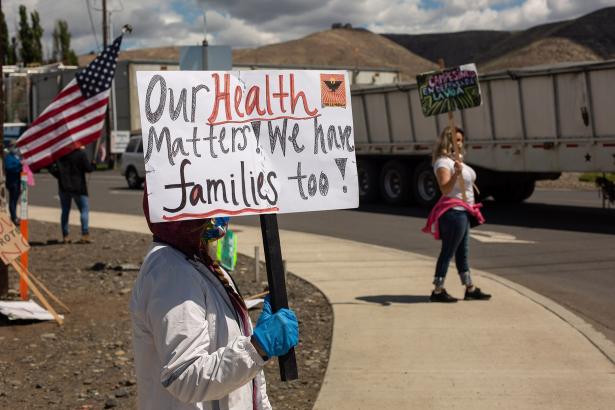The COVID-19 pandemic is taking a heavy toll on workers. Reports of job hazards grow increasingly dire as several governors and President Trump push past CDC guidelines to "reopen" the economy while forecasts predict soaring infections and deaths.
Some states at the direction of the Labor Department threaten termination of unemployment benefits for workers fearing return to dangerous jobs. A disturbing June 5 New York Times' report reveals how far those machinations have gone. The result: workers fired without pay or benefits or trapped in a deadly vice between poverty and disease.
In short, the news is terrifying – and rightly so. But it often misses essential information about rights workers have to save their own lives. First and foremost is the right to refuse unsafe work free of employer retaliation.
Whatever government says now, the Supreme Court affirmed that right in 1980, relying on regulations promulgated by the Occupational Safety and Health Administration, which publishes information online. An excerpt:
Your right to refuse to do a task is protected if all of the following conditions are met:
· Where possible, you have asked the employer to eliminate the danger, and the employer failed to do so; and
· You refused to work in "good faith." This means that you must genuinely believe that an imminent danger exists; and
· A reasonable person would agree that there is a real danger of death or serious injury; and
· There isn't enough time, due to the urgency of the hazard, to get it corrected through regular enforcement channels, such as requesting an OSHA inspection
This is no walk in the park. It affords an alternative to the "starve at home or die from work" choice confronting so many workers, but there are exceptions – and the path to safety can be rocky.
Although OSHA sets and enforces safety standards for most workplaces, budget and staffing cuts have impeded its ability to respond. Worse, the agency's initial COVID-19 policy limits intervention to health care providers or worksites where people have already died.
"That's one of the reasons why we're seeing catastrophic results in meatpacking plants, at Amazon warehouses, in transit systems, in other workplaces," former deputy Labor Department secretary Seth Harris said on MSNBC Live. "The cop is not on the beat."
OSHA's updated policy expands field staff's "discretion" in some cases. Not good enough, says the AFL-CIO, which is suing to compel immediate intervention in the face of "grave danger."
Ironically, these harsh realities reinforce workers' "right to refuse." In a blistering April 7 article for Politico, former OSHA administrator David Michaels said the agency "is suffering from malign neglect" under Trump, sparking worker job actions and strikes "to force their employers into providing even basic protections."
Collective action is bolstered further by workers' right to "concerted activities for...mutual aid or protection" under the National Labor Relations Act, which governs most private sector employment. Even the Trump-dominated Labor Board agrees that "participating in a concerted refusal to work in unsafe conditions" is protected.
But what about pay? Workers whose employers don't offer safe job assignments should be eligible for unemployment insurance, according to the National Employment Law Project, which is pressing the Labor Department to enforce and publicly clarify rules.
UI applies in "situations where there has been an intervening change in the conditions of work, which the employee objects to," NELP says. Workers getting new pandemic employment assistance shouldn't have to return to jobs that "present any unusual risk to the health, safety, or morals of the individual." NELP advocates CDC guidelines as a "baseline" to determine workplace safety.
Contracting COVID-19 on the job may be covered by state workers' compensation laws that generally require employer-provided insurance for disability pay and health care and also prohibit retaliation for pursuing or getting these benefits.
Proving work-related infection can be tricky (especially as Republicans deploy "blame the worker" talking points), but more states like Illinois and California make it easier to show a connection by presuming causation for some occupations.
The "no fault" nature of the insurance means there's no right to sue the employer, but there are exceptions, including gross negligence for failing to provide a safe workplace. State workers' comp laws vary. FindLaw summarizes them with links to agencies in charge.
As with almost every worker right, there are exclusions, caveats and case law that impact their interpretation and application. Advice: Get the facts, recruit co-workers if possible, expect a fight.
Employers could refuse to mitigate dangers, challenge claims or fire workers taking a stand, precipitating more battles over reinstatement and compensation. It's wise to consult a labor lawyer. Union workers have additional representation, a collective bargaining agreement and referrals to other services.
There's plenty more help from labor advocates. The AFL-CIO offers COVID-19 pandemic resources for workers, union and nonunion alike. The National Council of Occupational Safety and Health has guidance in English and Spanish.
The National Employment Law Project provides a "policy toolkit...to help ensure that workers are protected." And Labor Notes explains rights to paid leave and unemployment.
Bottom line: This fight for survival – however long it lasts – is universal. No one has to go through it alone.
[Kathy Wilkes – a longtime labor journalist and former union co-founder and officer – grants rights to reprint this article to pro-labor organizations. May 29, 2020. Updated June 7, 2020.]


Spread the word